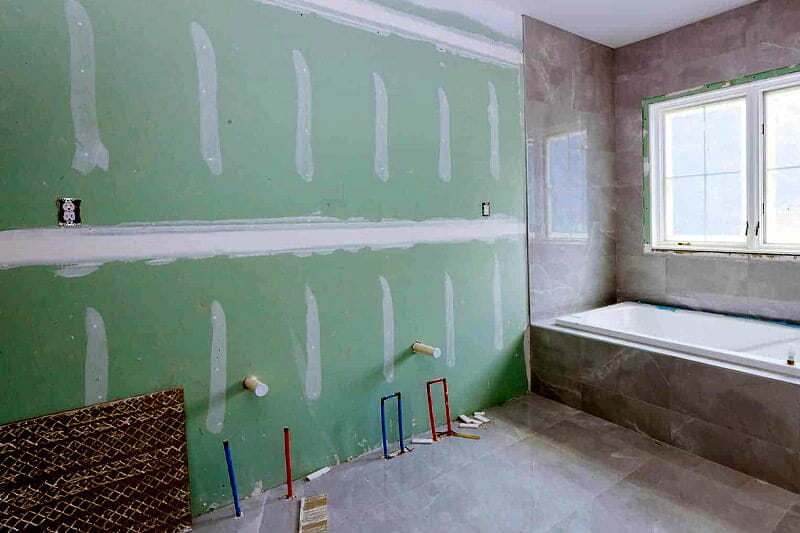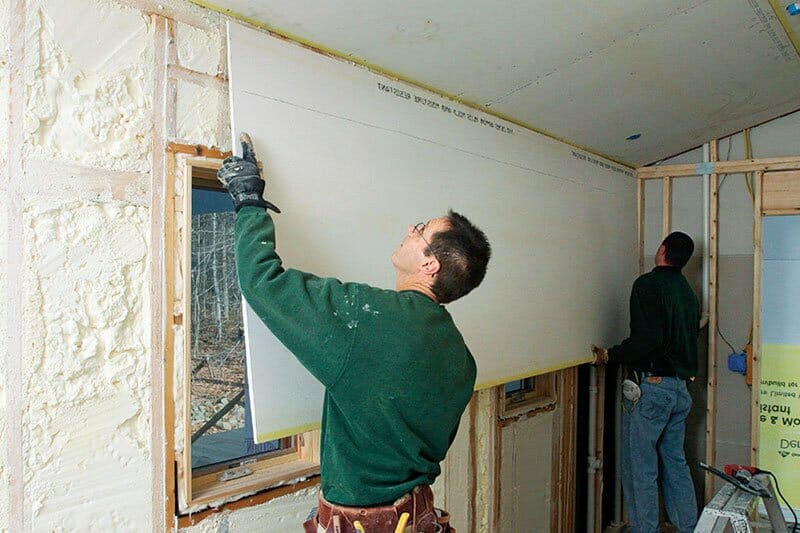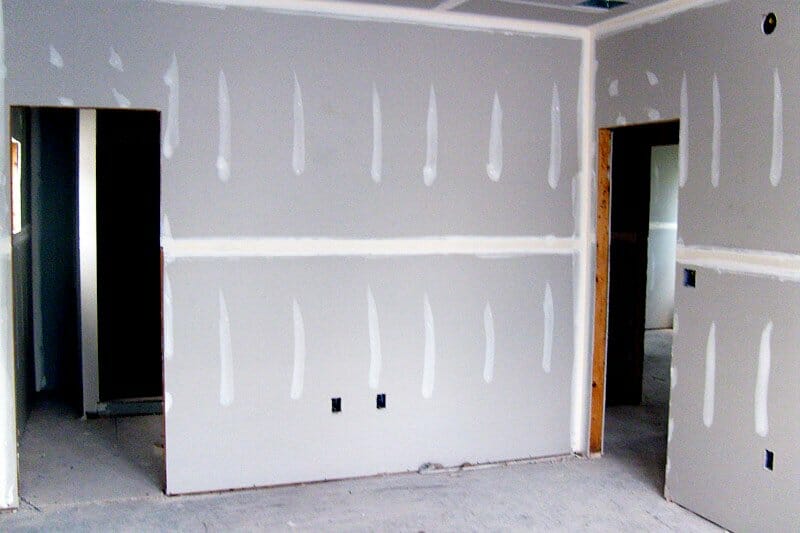Fire-resistant drywall panels, although appearing similar to conventional panels, are infused with materials like fiberglass to significantly enhance their fire resistance over traditional panels.
On average, fire-rated drywall, also called Type X drywall, costs about $20 to $30 per panel. This drywall comes in thicker sheets to slow burning. According to building standards, panels of ⅝” and ¾” thick are the best for areas such as the garage and staircase.
Fire-rated drywall panels cost more than regular drywall panels. Depending on the type of panels you buy, you can expect to pay at least 10-20% more than regular panels. Finishing your walls with fire-rated drywall panels is more expensive than using regular panels.
What we cover
ToggleWhat is fire-rated drywall
Fire-rated drywall is fire-resistant. It is rated according to its ability to withstand flames. Rating starts from 30 to 60 minutes.
Regular drywall is a mixture of gypsum and water. Fire-rated drywall has additional components such as fiberglass. It is also thicker than ordinary panels. Combined, the extra constituents and the thickness enhance its ability to slow a fire.
The rating on the fire-rated drywall must be ascribed by a third party. It must be tested by independent parties and must withstand a fire for a given time to meet the rating.
It is also known as Type-X or Type-C drywall. Type-C drywall is thicker and denser which makes it more fire-resistant.
Features of fire-rated drywall
Fire resistant
Fire-rated drywall is not fireproof. Rather, it is fire-resistant.
It is not fireproof since it will still burn. However, it is fire-resistant since it can slow down the spread of fire.
Its fire-resistant qualities have made it the recommended drywall in the building code. Building engineers recommend that you finish your home with fire-rated drywall.
Installation
A ⅝ inch fire-rated drywall must be installed with 2X4 studs spaced 16 inches from the center of one stud.
The installation instructions must be followed for your installation to meet building codes.
Thickness, composition, and rating
Regular drywall panels are available in ¼, ⅜, and ½ inch thicknesses.
You can buy fire-rated drywall in ½, ⅝, and ¾ inch panels. The thicker the panel, the higher its fire rating and the more fire-resistant it is.
Fire rating measures how long the panel can slow down flames. The ½ inch panels withstand flames for 45 minutes, ⅝ inch for 60 minutes, and the ¾ inch panel for two hours.
The fire-rating must be conducted by a different party from the manufacturer. Different thickness drywall must meet the set conditions for its size and density.
Cost
Fire-rated drywall is as available as regular drywall. You can buy it from your local home improvement store. However, it will be more expensive.
It costs at least 20% more than ordinary drywall. Finishing your walls with fire-rated drywall costs $1.5-$2.5 per square foot, while using regular drywall panels costs $1-$1.5 per square foot.
You will pay $11 for ⅝ inch fire-rated drywall panel and $12 for the ¾ inch panels.
Performance
If you are looking to buy fire-rated drywall, you can get Type C or Type X. They both have superior fire-resistance capabilities but Type-C is much better.
Type-C is thicker and contains more fiberglass than Type-X panels. It also has a mineral known as vermiculite which is more fire resistant than fiberglass. Vermiculite expands when heated which reduces the spread of fire.
The use of fire-rated drywall also impacts the building code. It ensures that your building projects or finished garages meet the international building code on fire safety.
Easy to use
Fire-rated and regular drywall is easy to use. It can be cut and hung easily. You can DIY or hire a pro to finish the installation in a few hours.
With the right skills and tools, you can DIY fire-rated drywall installation in a garage. For a large room, drywall installation is a two-person job.
It is easy to cut and hang on walls.
Where to install fire-rated drywall
Fire-rated drywall is installed on specific parts of the house. These include:
- Garages
- Fireplace area
- Utility rooms
- Garage ceilings with living rooms above them.
Hire a pro to install your fire-rated drywall
Homegardenguides.com is a free tool to hire professional drywall installation service providers.
It connects homeowners to professionals in the following easy steps.
- Enter your zip code at the top of the tool.
- Fill in the form to provide more details about the drywall service you need.
- You will receive three or four quotes and advice from professional drywall materials and installation companies
- Contact and hire a drywall installation service that falls within your budget.

Other types of drywall and their uses
Regular drywall
It is the ordinary most common drywall. It is also the most affordable.
It is white on one side and brown on the other. It is available in different sizes and is used for a range of projects.
Green board drywall
It is white with a green layer covering it. The layer makes it more moisture-resistant compared to regular drywall.
Green board drywall is not waterproof. It is used as a tile backer and installed in rooms or locations of little wetness. It can be installed in bathrooms, kitchens, and utility rooms. Make sure it does not come into direct contact with water.

Blue board drywall
It is also known as plaster baseboard. It has superior absorption capabilities and is used for veneer plastering.
Install blue board drywall in bathrooms due to its water and mold resistance qualities.

Paperless drywall
Paperless drywall is drywall covered with fiberglass instead of paper. Consequently, the fiberglass ensures that the drywall does not rot and is mold and mildew resistant.

Purple drywall
Purple drywall is similar to regular drywall. However, it has a purple cover and is more moisture and mold-resistant.
It is installed on walls and ceilings. It is best used in wet and moist regions. It can also be installed in bathrooms and other places with water due to its superior moisture resistance qualities.

Soundproof drywall
If you want to reduce noise, soundproof drywall is the most ideal. It is heavier, thicker, and harder to cut.
It can be installed in offices, garages, and homes to block noise from outside.














